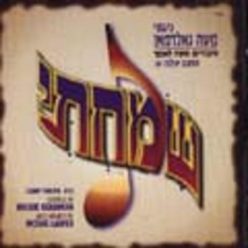Rav Moshe Wolfson shlita mashgiach of Mesivta Torah Vodaath and rav of Bais HaMedrash Emunas Yisrael in Boro Park has for many years taken his talmidim to experience the kedushah of the ancient kevarim and other holy sites in Eretz Yisrael. On each of these excursions the group davens together at each place they visit after which the Mashgiach speaks about the unique spiritual power of that specific site. Afterwards they sing niggunim specially chosen to tap into the distinctive spiritual energy of that particular place. Rav Wolfson’s sefer Sacred Soil — a guided tour through the spiritual essence of Eretz Yisrael — examines the holy riches of Eretz Yisrael and its mekomos hakedoshim and is accompanied by a list of niggunim to complete the travelogue and enable the visitor to personally feel the connection. Here’s a sampling of niggunim from those trips:
MEARAS HAMACHPEILAH
Here in the very field that Avraham Avinu purchased from Ephron Rav Wolfson suggests davening that Hashem hear our prayers in the merit of the Avos and Imahos. The heartwarming chassidic song “Kah zechus Avos yagen aleinu netzach Yisrael mitzoroseinu ge’aleinu …” whose poetic words from the Shalosh Seudos zemer “Keil Mistater” freely translate as “Hashem let the merit of the forefathers shield us Eternal One of Israel redeem us from our sorrows. And draw us out from the pit of galus; raise us up to orchestrate the building of the House of Hashem.”
Keil Mistater is a mystical zemer composed by Rav Avraham Maimon a talmid of Rav Moshe Cordovero in 16th-century Tzfas. This particular tune rousing and full of hope was composed by Reb Menachem Klein. The tune is popular in Nadvorna and other chassidic circles and is often used as a mitzvah tantz niggun especially where the young couple have illustrious forebears who — according to the mystical seforim — are said to be partaking in the simchah.
Another appropriate song is Reb Moshe Goldman’s “Ahavas Olam Tovi Lahem ” which states that Hashem will lovingly recall His promises to the Avos. Drawn from the Mussaf of Rosh Chodesh it carries just the right balance of yearning and leibedig assurance.
KEVER SHIMSHON
The burial place of the mighty shofeit Shimshon Hagibbor is in the region of Beit Shemesh. Shimshon dedicated his life to exacting revenge against the cruel enemies of the Jewish people instilling fear in them and thus preventing further attacks. Therefore Rav Wolfson suggests singing the pesukim from Tehillim 79 which ask Hashem to avenge the innocent Jewish blood that has been ruthlessly spilled. “Yivodah bagoyim — May the vengeance of Your servants’ spilt blood be made known among the nations before our eyes. May the groans of the imprisoned come before you… preserve those [of Your] children who have been condemned to die. Repay our [wicked] neighbors seven times the dishonor with which they shamed you Hashem!” The haunting niggun for these words was composed by the previous Skulener Rebbe ztz”l while he was imprisoned by the Romanian Communists who persecuted him unrelentingly until he was finally permitted to immigrate to the United States in 1960.
Rav Wolfson explains that another facet of Shimshon’s essence was his standing as champion of the final generation. Shimshon understood the latent greatness of even the spiritual paupers among Klal Yisrael and prayed for their redemption at the End of Days. The vintage niggun “Sheb’shifleinu Zochar Lanu — You remembered us in our lowliness and redeemed us from our tormentors ” is a perfect fit.
KEVER SHIMON HATZADDIK
Jerusalem is studded with hidden treasures and this is one of them. Walk down the road in Maalot Dafna that bears his name cross over Kvish 1 and there lies the kever of Shimon Hatzaddik. As a pivotal figure in the transmission of the Oral Torah Shimon Hatzaddik taught that the world is dependent upon Torah learning as well as on prayer and acts of kindness. Rav Wolfson suggests connecting to this with another song composed by the first Skulener Rebbe — “Lulei Sorascha Sha’ashuai.”
(Originally featured in Mishpacha Issue 685)



